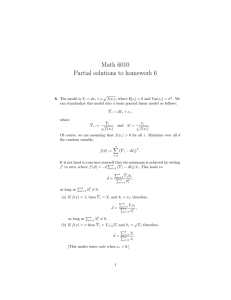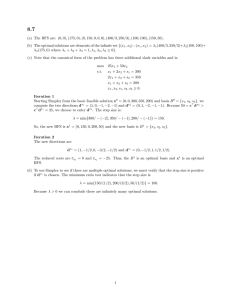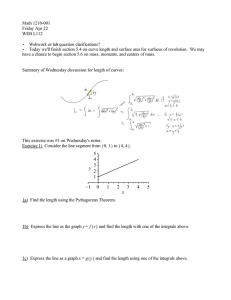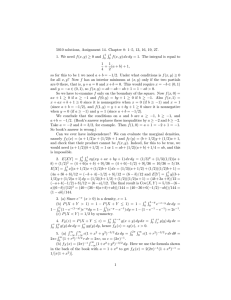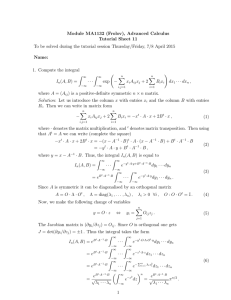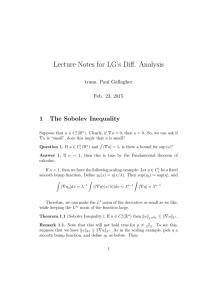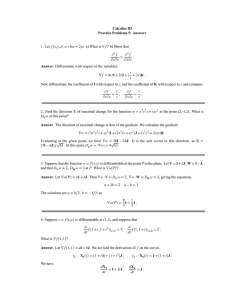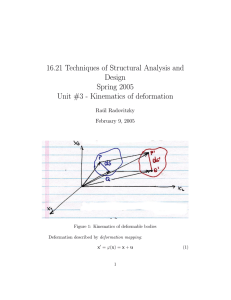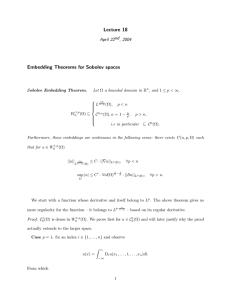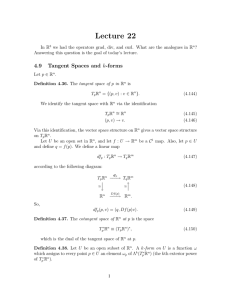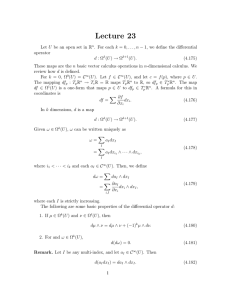34. Forms on R dx
advertisement
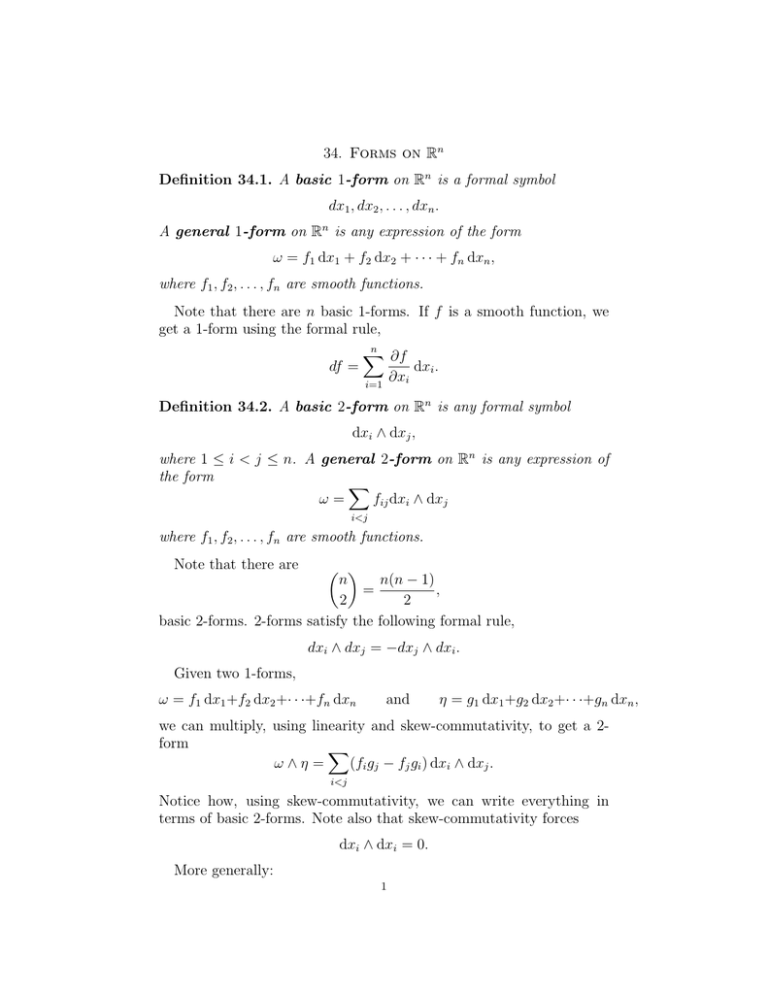
34. Forms on Rn Definition 34.1. A basic 1-form on Rn is a formal symbol dx1 , dx2 , . . . , dxn . A general 1-form on Rn is any expression of the form ω = f1 dx1 + f2 dx2 + · · · + fn dxn , where f1 , f2 , . . . , fn are smooth functions. Note that there are n basic 1-forms. If f is a smooth function, we get a 1-form using the formal rule, df = n � ∂f dxi . ∂x i i=1 Definition 34.2. A basic 2-form on Rn is any formal symbol dxi ∧ dxj , where 1 ≤ i < j ≤ n. A general 2-form on Rn is any expression of the form � ω= fij dxi ∧ dxj i<j where f1 , f2 , . . . , fn are smooth functions. Note that there are � � n n(n − 1) = , 2 2 basic 2-forms. 2-forms satisfy the following formal rule, dxi ∧ dxj = −dxj ∧ dxi . Given two 1-forms, ω = f1 dx1 +f2 dx2 +· · ·+fn dxn and η = g1 dx1 +g2 dx2 +· · ·+gn dxn , we can multiply, using linearity and skew-commutativity, to get a 2­ form � ω∧η = (fi gj − fj gi ) dxi ∧ dxj . i<j Notice how, using skew-commutativity, we can write everything in terms of basic 2-forms. Note also that skew-commutativity forces dxi ∧ dxi = 0. More generally: 1 Definition 34.3. A basic k-form on Rn is a formal symbol dxi1 ∧ dxi2 ∧ . . . dxik , where 1 ≤ i1 < i2 < · · · < ik ≤ n A general k-form on Rn is any expression of the form � ω= fi1 i2 ...ik dxi1 ∧ dxi2 ∧ . . . dxik , 1≤i1 <i2 <···<ik ≤n where fi1 i2 ...ik are smooth functions. Note that there are � � n , k basic n-forms. Suppose we start with a general 1-form in R3 , ω = f1 dx + f2 dy + f3 dz. We can formally define a 2-form dω as follows: dω = d(f1 dx + f2 dy + f3 dz) = df1 ∧ dx + df2 ∧ dy + df3 ∧ dz � � ∂f1 ∂f1 ∂f1 = dx + dy + dz ∧ dx ∂x ∂y ∂z � � ∂f2 ∂f2 ∂f2 + dx + dy + dz ∧ dy ∂x ∂y ∂z � � ∂f3 ∂f3 ∂f3 + dx + dy + dz ∧ dz ∂x ∂y ∂z � � � � � � ∂f2 ∂f1 ∂f3 ∂f1 ∂f3 ∂f2 = − dx ∧ dy + − dx ∧ dz + − dy ∧ dz. ∂x ∂x ∂y ∂y ∂z ∂z Note also that if ω = f12 dx ∧ dy + f13 dx ∧ dz + f23 dy ∧ dz, then we can formally define a 3-form dω as follows: dω = d(f12 dx ∧ dy + f13 dx ∧ dz + f23 dy ∧ dz, ) � � ∂f12 ∂f13 ∂f23 − = + dx ∧ dy ∧ dz. ∂z ∂y ∂x The final interesting formal operation on k-forms is: Definition 34.4. Let ω be a k-form on Rn . The Hodge star oper­ ator assigns an (n − k)-form ∗ω to ω, which is defined by the rule: (∗ω) ∧ ω = dx1 ∧ dx2 ∧ · · · ∧ dxn . 2 Let’s figure out what the Hodge star operator does in R3 . Suppose that ω = dx ∧ dy. Then η = ∗ω is a 1-form such that η ∧ ω = dx ∧ dy ∧ dz. It follows that η = dz. Similarly ∗(dx ∧ dz) = −dy and ∗ (dy ∧ dz = dx). Let ω = f1 dx + f2 dy + f3 dz. Putting all of this together, we see that ∗dω = ∗d(f1 dx + f2 dy + f3 dz) � � � � � � ∂f3 ∂f2 ∂f3 ∂f1 ∂f2 ∂f1 = − dx − − dy + − dz. ∂y ∂x ∂x ∂z ∂z ∂y Similarly ∗d ∗ ω = ∗d ∗ (f1 dx + f2 dy + f3 dz) = ∗d(f1 dy ∧ dz − f2 dx ∧ dz + f3 dx ∧ dy) � � ∂f3 ∂f2 ∂f1 =∗ + + dx ∧ dy ∧ dz ∂z ∂y ∂x ∂f1 ∂f2 ∂f3 = + + . ∂x ∂y ∂x In other words, curl = ∗d and div = ∗d ∗ . Note that this points to a way to unify the various versions of the fundamental theorem of calculus for surfaces and threefolds (namely, the theorems of Green, Stokes and Gauss). One can also use this notation to express Maxwell’s equations quite efficiently. But these are both other stories. 3 MIT OpenCourseWare http://ocw.mit.edu 18.022 Calculus of Several Variables Fall 2010 For information about citing these materials or our Terms of Use, visit: http://ocw.mit.edu/terms.
